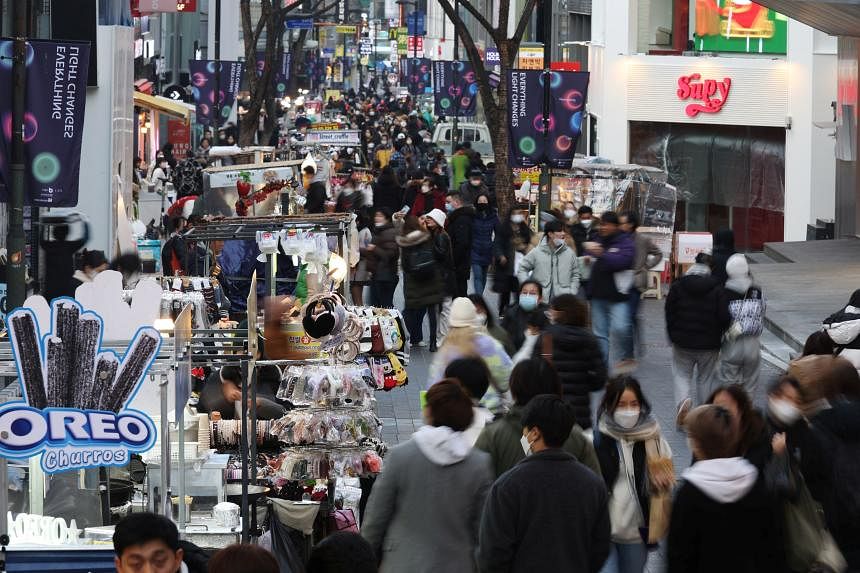SEOUL - When Ms Kelly Yoon, a 38-year-old mother from the middle-class enclave of Songdo on the outskirts of Seoul, attended a school event for her nine-year-old daughter, she was stunned by the designer goods on the other mothers.
“I saw all kinds of Chanel bags on my way to the classroom,” she said.
“Mothers love Bulgari’s Diva’s Dream and Van Cleef & Arpels’ jewellery collections, and a Moncler winter jacket is actually a ‘uniform’ for mums here. The most popular car is a Mercedes-Benz sport utility vehicle.”
It is a scene playing out across the country, where a potent mix of status seekers, cashed-up home owners and Yolo-ing (you only live once) millennials has combined to make South Koreans the world’s biggest per-capita spenders on luxury brands.
South Koreans’ spending on personal luxury goods, from designer handbags to US$2,000 (S$2,600) puffer jackets, rose 24 per cent to 21.8 trillion won (S$23.2 billion) in 2022 – equal to about US$325 for every man, woman and child, according to a Morgan Stanley report published earlier in January.
Helping to fuel the surge was South Korea’s runaway housing boom, which saw property prices in some cities double during the pandemic, making home owners feel wealthier.
On the flip side, younger South Koreans despairing they would never get on the property ladder decided instead to spend their income on luxury treats.
The trend mirrors a global upswing in luxury spending, driven in part by growing affluence worldwide, that has helped propel Mr Bernard Arnault, the French tycoon behind luxury-goods powerhouse LVMH, to become the world’s richest person.
“Everyone seemed so optimistic about their future during the pandemic,” said Dr Lee Wonjae, a sociology professor at Kaist Graduate School of Culture Technology in Daejeon.
“Consumer confidence was so strong because stocks, cryptocurrency and housing prices were rising. Even though some people missed the opportunities, their friends were making money, so they believed everything was going to be like this forever.”
Dr Ahn Dong-hyun, an economics professor at Seoul National University, said that millennials have also contributed to the luxury boom.
“They might have given up on buying a house and try to make themselves happy by buying expensive stuff instead.”
According to a 2022 report from retail giant Lotte Group’s member loyalty unit, purchases of luxury goods by people in their 20s jumped 70 per cent in 2021 compared with 2018, the strongest growth among all age groups.
Ms Christine Lee, a 30-year-old worker who earns about US$24,000 a year at an insurance company, said she bought a 1.6 million won Marni handbag in 2020.
“All my friends have at least one luxury handbag,” she said.
“South Korea’s Gen Z has a motto: Yolo. We can’t buy a house, it’s too expensive, so why should we save money for the future?”
Instagram posts bragging about luxury shopping also affected her, Ms Lee said.
South Korea was ranked No. 3 in the world by active social media users, who make up 91.2 per cent of the population, according to a 2022 report from Hootsuite.
The rise of South Korean pop culture, led by boy band BTS and Oscar-winning film Parasite, has prompted top fashion houses and luxury brands to sign South Korean stars as ambassadors.
Celebrities such as Squid Game actress Hoyeon Jung endorse brands including Louis Vuitton and Bentley on Instagram, while the members of girl band Blackpink endorse luxury companies including Chanel, Bulgari, Cartier and Tiffany.
Dior announced in January that it has signed BTS member Jimin as a global ambassador. He was mobbed by fans screaming and chanting his name at a Paris fashion show last week.
The importance of appearance can resonate more with South Korean consumers, with spending on cosmetic surgery appearing to start at a younger age and to be far higher than in most other countries, said Morgan Stanley analysts.
With a population of just 51 million, South Korea is now as important as Japan, which has a population of 125 million, for luxury goods makers. South Korean nationals account for 10 per cent or more of total retail sales by top-end brands such as Prada, Moncler, Bottega Veneta and Burberry Group, the report said.
“As for status, a number of studies have shown that financial success tends to be highly valued in South Korea, so personal luxury goods can be an important tool to create social stratification,” said Morgan Stanley.
In China, luxury spending works out to around US$55 per person, the report added.
But some headwinds are coming.
South Korea’s household debt is higher than that of Japan, Britain and the United States, and the Bank of Korea has increased its key policy rate to 3.5 per cent from a low of 0.5 per cent in July 2021, bringing the era of cheap money to an end.
Real estate prices in South Korea fell by the most in the world in the third quarter of 2022.
“This kind of a boom won’t last forever, and we might be seeing something similar with what happened in the 1990s in Japan”, after the so-called Bubble Economy burst, said Dr Lee. BLOOMBERG


